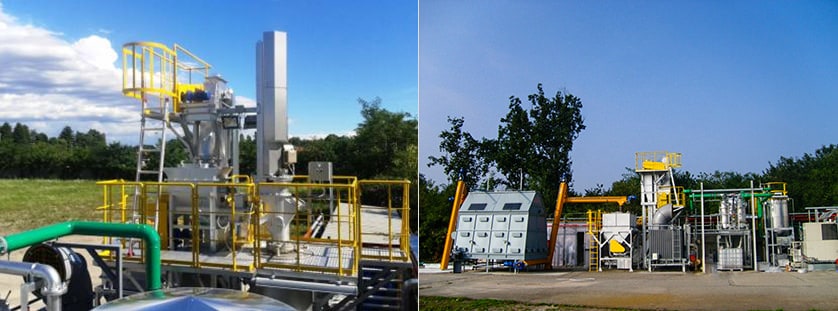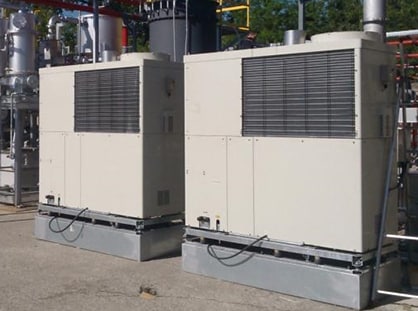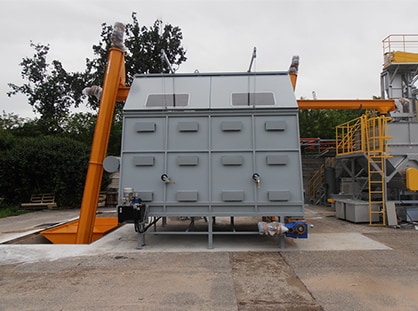Yanmar R&D Europe
ヤンマーテクニカルレビュー
First YANMAR Gasification system in Europe
1. Introduction
From 2005 to 2012 renewable electricity generation in Europe grew by 61% (average pace of 7.1%/year), whereas the overall electricity generation remained unchanged over this period. As a consequence, the share of renewable energy in gross electricity generation reached 24.1%. Solar photovoltaic has the highest annual average grow rate (72.8% in 2005-2012), followed by Wind and Biogas/Biofuels.
Regarding Solid biofuels, that are used in gasification systems, the average grow rate in 2005-2012 was 9.1%.
One of the reasons of the spread of renewable energies has to be found in the policies of the European states, that introduced incentives and feed-in tariffs since the nineties.
Considering this steady and constant growth, it is clear that Europe represents a good and advanced test bed in which to apply new solutions and new technologies in the field of renewable energies.
According to this favorable scenario, Yanmar Co. and Yanmar R&D Europe decided to proceed with the first installation of the Yanmar gasification system in Europe.
2. Background of the Project
One of the most critical aspects of the renewable energies (speaking about solar and wind energy) are their unpredictability and non-programmability. This characteristic, combined with their fast growth, is causing problems to the electric power grid in terms of stability and efficiency. In fact, the uncontrolled and intermittent feed-in of electricity increases the difficulty to match production with demand, decreasing at the same time the efficiency of traditional thermal-power plant.
On the contrary, gasification systems are able to use a renewable source, represented by solid biomasses, in a controllable way. In fact the energy can be stored in the form of woodchips and used in the gasification system according to the need.
From the point of view of environmental sustainability, Yanmar gasification system can exploit different kinds of solid biomasses that are broadly spread on the territory (from Mediterranean to northern countries) and easily available with an environmental impact which is negligible or zero (for example maintenance of forests and cultivated lands).
For the above reasons Yanmar gasification represents a technology that is very well suited for European society, being at the same time renewable and controllable.
3. Yanmar gasification system description
3.1. Brief introduction to Yanmar gasification technology
Gasification is a process that converts an organic carbon material into a burnable gas mainly composed by CO, H2 and CO2. The chemical reactions take place in a controlled environment (usually inside a reactor) with a small amount of air in order to prevent the combustion.
Yanmar gasifier is composed by a downdraft fixed-bed open-top reactor, a water-based gas cleaning system and two Yanmar micro-cogenerators (internal combustion engines with integrated heat recovery). All the system is designed and manufactured in Japan by Yanmar.
The choice of using a water-based cleaning system has the advantage to produce a gas that is very clean and that can more easily used in the micro-cogenerators, increasing reliability and maintenance intervals for the engines.
3.2. Installation in Yanmar Italy
In the middle of 2014, the installation of Yanmar gasification system was started in Yanmar Italy (a subsidiaries of Yanmar Co., Ltd.) that is the worldwide manufacturer of the Yanmar L-Series (Air cooled Diesel Engine).
The total electric power generated by the two cogenerators is 40 kW and the total thermal power is 66 kW (in the form of hot water delivered to the factory through pipelines).

The decision to install the gasification plant in a factory of Yanmar group has many advantages: from the research point of view, it is possible to have logistic and technical support to test new configurations and additional devices; from the company point of view, thanks to the use of Yanmar cogenerators, they can reduce power absorption from the electrical grid and use the heat from the cogenerators to reduce the use of gas boilers. In addition, Yanmar gasification system is eligible for the incentives granted to the plants that are using solid biomasses (which are one of the highest incentives among renewables), with the additional bonus of the high efficiency cogeneration.


(1) Drying system
One of the key features to increase the flexibility of Yanmar gasification system is the possibility to dry autonomously the woodchip up to the humidity content required by the gasifier. Thanks to this, we can increase the possibilities to purchase the woodchip (at a lower cost) also from the companies that are not equipped with their own drying systems (that are the majority).

Another target was to make a storage for the woodchip in order to increase the working range of the gasifier and feed it automatically with the correct quantity at the correct humidity.
Finally the best solution was identified and the manufacturing and installation was carried out just after the installation of the gasifier.

The drying system was designed by Yanmar R&D Europe and manufactured by a local company. The target of the project was to reach the maximum efficiency of the process using part of the thermal energy coming from Yanmar cogenerators. A fluid dynamic 3-D simulation was performed to assess the best shape and position of hot air ducts inside the dryer.
(2) Inauguration
The Gasification system was officially inaugurated December 10th 2014 with an opening ceremony at the presence of Yanmar personnel, Universities and companies in the energy sector potentially interested in the application of this technology.
4. Present situation and Future development
The gasification system is currently running using woodchip coming from the maintenance activities of local forests. All its parameters are being monitored in order to assess its performances in terms of efficiency, operating costs and benefits.
Development activities are proceeding to increase the efficiency and the automation level of the gasifier plant. In particular, to reduce the time requested for daily maintenance operations, an automatic suction system was realized to remove in a fast and safe way the char produced by the gasifier. In order to increase the efficiency and at the same time to further reduce the disposal costs, Yanmar R&D Europe is analyzing different strategies for the valorization of the removed char. The most promising solutions are the reuse as a fertilizer and the internal use in a boiler installed besides the gasification system. This second option is particularly dedicated to enhance the total thermal energy recovered from the plant.
5. Next steps
Starting from the results of the first installation in Yanmar Italy, Yanmar R&D Europe is proceeding with the feasibility analysis for the application of a gasification system in an olive and wine farm in Tuscany. The basic idea is to develop a local and sustainable agro-chain, from the use of pruning residues in the gasifier to the efficient exploitation of electricity and thermal energy in the production processes of the farm.
Author
